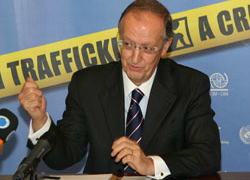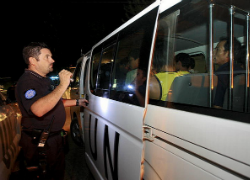This is the second blog of a series of three blog posts addressing technological solutions to combat human trafficking. This post discusses the importance of the increased use of technology in the fight against human trafficking and provides an overview of the scope of current research on technology and trafficking. The first blog in this series discussed the scope of human trafficking worldwide, and domestic international instruments designed to address it. The final blog in this series will analyze the efforts private partnerships to apply technology to create anti-trafficking solutions.
“Our understanding of technology’s role in human trafficking, while improving, is still in its infancy. Technology, while clearly facilitating trafficking, also can be used as an effective tool to combat it. Evidence-based research that examines the two sides of this issue is imperative for leveraging technology and policy approaches to benefit the vulnerable populations being exploited through trafficking.” – Mark Latonero, The Rise of Mobile and the Diffusion of Technology-Facilitated Trafficking[i]
Part II: Technology’s Conflicting Roles in Human Trafficking
Human trafficking has increased in intensity in the past few decades, likely facilitated by globalization and the availability of modern communication techniques. Just as modern technology enabled legal businesses to span oceans and cross borders, it also assisted criminal endeavors such as trafficking in persons. In a speech at the 2008 Vienna Forum to Fight Human Trafficking, United Nations Office on Drugs and Crime (UNODC) Executive Director Antonio Maria Costa said:

In the past quarter century, the opening up of world markets has facilitated the movement of people, goods, capital and services–commerce has benefited, and so has illicit activity, including the trade of human beings. The ease of travel, the speed of the internet, and global competition have rendered the exploitation of humans by humans easier, broader and more efficient.[ii]
Mr. Costa references “the speed of the internet,” which global citizens appreciate and utilize on a daily basis to connect in seconds with like-minded people, regardless of geographic location. His statement is a reminder that this instant connectivity has bred exploitation and abuse even as it has produced camaraderie and business success.
Speedy and discrete, the worldwide web has played perhaps the most significant role in hiding exploitation from the average person, while simultaneously making it ubiquitous everywhere. This is precisely why activists are beginning to focus on understanding the power the internet and other evolving technologies have to eradicate the very problems they have allowed to prosper.
As the role of technology in facilitating human trafficking continues to expand, anti-trafficking advocates across all sectors—government, nonprofits, private enterprise—are attempting to keep up with traffickers by learning how to analyze data and track electronic activity in a way that makes it easier to locate and punish traffickers, and to rescue their victims. The first step toward finding a comprehensive solution to human trafficking, as Mr. Costa stated, is figuring out a way to quantify the problem at hand with statistical data:
In order to fight this monster [of human trafficking], we must know more about it. Lack of information, statistical and otherwise, have left us looking at footprints of a creature whose shape, size and ferocity we can only guess. It lurks in the shadows. The profiles of its cronies and their networks are sketchy. Its victims are too afraid to run away and speak up, their number unknown.[iii]
Mr. Costa’s pleas from 2008 have not gone unheeded, but neither have leaps and bounds been made in this area. A July 2013 report from the Congressional Research Service reiterates the necessity for data on the global scope and severity of human trafficking in order to begin forming effective solutions. According to the report, the State Department’s Trafficking in Persons Report is “among the most cost-intensive in terms of personnel resources both at U.S. diplomatic posts abroad and at headquarters in Washington, DC.”[iv] A single embassy reported that approximately 200 hours of work were required to resolve questions and differences in information for a TIP Report.[v]
Increasing the utilization of technology, especially data mining services, may eventually be able to alleviate the cost-intensive nature of data collection by making the necessary information easier to spot. Meaningful data, the report states, are essential both to measuring and reporting the scope of the problem in reports such as the TIP Report, and for assessing how anti-trafficking aid programs have improved the situation.[vi]
A group of academics has been called upon to lead the way in understanding and utilizing technology to develop trafficking solutions. Researchers at the University of Southern California’s (USC) Annenberg’s Center on Communication Leadership & Policy have completed some of the most comprehensive, relevant reporting on the intersection of technology and human trafficking. This video provides an overview of their project’s inception and some of the most relevant findings to date:
The USC Center compiled a report in November 2012, discussing how human traffickers are “taking advantage of technology to reach larger audiences and to do illicit business more quickly and efficiently across greater distances.”[vii] Asserting that technology must respond to this phenomenon by becoming a “central tool within a comprehensive strategy”[viii] against trafficking, the report mentions the following research efforts already underway:[ix]
- The National Institute of Justice (NIJ) released one report, Identifying Challenges to Improve the Investigation and Prosecution of State and Local Human Trafficking Cases, which identifies the internet both as a tool for facilitating trafficking and for locating and prosecuting it – law enforcement located 27 percent of the trafficking cases in the study through the internet.[x]
- In a second report, A National Overview of Prostitution and Sex Trafficking Demand Reduction Efforts, the NIJ again highlights the fact that, while technology does facilitate trafficking, law enforcement is using that to its advantage, as approximately one third of all police departments that conduct street-level reverse stings have implemented web-based reverse stings.[xi]
- The Department of Justice’s Project Safe Childhood released The National Strategy for Child Exploitation Prevention and Interdiction, which identifies cyber crime as an increasing threat and outlines the Department’s approach to protecting children from trafficking. The approach is multifaceted and involves many organizations within the Department of Justice. One especially relevant aspect of the strategy involves the FBI’s Innocent Images National Initiative, which is aimed specifically at ending technology-facilitated child exploitation.[xii]
- Microsoft Research released a report, Human Trafficking and Technology: A Framework for Understanding the Role of Technology in the Commercial Sexual Exploitation of Children in the U.S., which explores how technology has impacted the human trafficking ecosystem. The report primarily focuses on establishing a framework for considering these issues further. Its authors state:
Fears and anxieties emerge out of concern that things will get worse as a result of technology. Yet, new opportunities also present themselves. Before we wholeheartedly dismiss—or embrace—technology, it’s important to understand how the challenges and opportunities are entangled.[xiii]
- Researchers at the University of New Hampshire’s Crimes Against Children Research Center have mined data to find victim information such as age ranges, gender disparities, treatment by police, and independent or group structures. They have also used data to identify perpetrator characteristics for different groups, and the effects of reporting suspected human trafficking, among other issues.[xiv]
Finally, the report discusses a 2010 article by Erin I. Kunze, who conducted an assessment of laws, international agreements, and other policies relating to Internet-facilitated sex trafficking. Kunze suggests that international laws are not sufficiently keeping pace with advancing technology. The article argues that, “[I]t is vital that the international community adopt both domestic legislation and international treaty provisions to target sexual predators and human traffickers who use technology and the Internet to enslave minors and adults alike.”[xv]
Kunze’s article highlights a debate within the international legal community over whether the language of current instruments sufficiently encompasses and criminalizes the technological facilitation of trafficking. For example, while the members of the Council of Europe argue that the term “recruitment” as it is used to define trafficking in the 2000 Protocol to Prevent, Suppress and Punish Trafficking in Persons (“2000 Protocol”) is sufficiently broad enough to include recruitment via online technology, Kunze retorts that even a broad interpretation of the word does not go far enough to cover specific acts of exploitation occurring online.[xvi]

At this stage, Kunze’s pronouncements appear premature. As the United Nations suggested in a 2005 statement, attempts to create and refine technology-specific laws will remain premature as long as governments have not perfected their ability to enforce laws already in existence. This is especially true given the fact that, as the first blog in this series noted, international instruments criminalizing trafficking have existed since at least 1926. That first convention, the Convention to Suppress the Slave Trade and Slavery, prohibits all acts of slavery and every act of trade or transport of people, seemingly encompassing the acts that take place in virtual spaces today. The 1979 Convention on the Elimination of all Forms of Discrimination Against Women likewise encompasses all forms of traffic in women. Finally, the 2000 Protocol uses words of direction including “prevent,” “combat,” “protect,” “assist,” and “promote cooperation,” all of which can be done in virtual spaces as well as physical ones.
Slavery does not persist because of a dearth of legal instruments with the capacity to combat it – it persists because it is difficult to track and understand. The international community should refrain from drafting premature legal instruments until it has gained a more thorough, comprehensive understanding of how human traffickers operate. Technology-specific language at the international level may eventually prove necessary to adequately address the increased use of the internet in perpetrating trafficking. However, it is more likely that as more information becomes available through the increased use of data mining and analysis, the existing language will prove adequate.
Arguably, this debate will not be resolved conclusively until more signatories to the Protocol actually begin to carry out its mandate by locating and prosecuting more cases of human trafficking within their borders. To do this, advocates must focus on compiling enough information on the problem to take decisive action against perpetrators. Only when trafficking cases reach the courtroom will we be able to test the functionality of the 2000 Protocol, and the domestic legal instruments based on the 2000 Protocol, as they are written.
Existing instruments may be sufficient to encompass violations that take place across digital spaces. What advocates lack is sufficient information to make this possible. As the third blog in this series discusses, several private partnerships are conspiring to change that.
Whitney Denning is a 3L and a staff editor for the Denver Journal of International Law & Policy.
[i] Mark Latonero et al., The Rise of Mobile and the Diffusion of Technology-Facilitated Trafficking 8 (2012), available at https://technologyandtrafficking.usc.edu/files/2011/08/HumanTrafficking2012.pdf.
[ii] Antonio Maria Costa, Exec. Dir. United Nations Office on Drugs and Crime, Human Trafficking: A Crime that Shames Us All (Feb. 13, 2008), available at http://www.unodc.org/unodc/en/about-unodc/speeches/2008-02-13.html.
[iii] Id.
[iv] Liana Sun Wyler, Cong. Research Serv., R42497, Trafficking in Persons: International Dimensions and Foreign Policy Issues for Congress 10 (2013).
[v] Id. at 11.
[vi] Id. at 14.
[vii] Latonero et al., supra note 1, at iv.
[viii] Latonero et al.,, supra note 1, at vi.
[ix] Latonero et al.,, supra note 1, at 11.
[x] Amy Farrell et al., Identifying Challenges to Improve the Investigation and Prosecution of State and Local Human Trafficking Cases 41 (2012).
[xi] Michael Shively et al., A National Overview of Prostitution and Sex Trafficking Demand Reduction Efforts, Final Report 47 (2012).
[xii] U.S. Dep’t of Justice, The National Strategy for Child Exploitation Prevention and Interdiction 4 (2010).
[xiii] Danah Boyd et al., Human Trafficking and Technology: A Framework for Understanding the Role of Technology in the Commercial Sexual Exploitation of Children in the U.S. 3 (2011).
[xiv] Latonero et al., supra note 1, at 13.
[xv] Erin I. Kunze, Sex Trafficking Via The Internet: How International Agreements Address The Problem And Fail To Go Far Enough, 10 J. High Tech. L. 241, 253 (2010).
[xvi] Id. at 272.


